University: NUR212 Assignment - Asthma in Children and Youth
VerifiedAdded on 2022/10/04
|11
|2992
|439
Report
AI Summary
This report provides a comprehensive overview of asthma in children and youth, examining the condition's prevalence, symptoms, and impact. It identifies and discusses key health policies, including those from WHO and national strategies, focusing on medication, education, and environmental factors. The report applies principles of health promotion and primary care, emphasizing holistic, patient-centered approaches and community-based interventions. It also explores the role of advocacy in promoting asthma-friendly policies and legislation, particularly in relation to environmental and medical issues. Furthermore, the report addresses the principles of equity, rights, and access, specifically in the context of Aboriginal and Torres Strait Islander families, highlighting disparities in healthcare access and advocating for culturally tailored services and asthma education to improve health outcomes within these communities. The report is supported by relevant references.
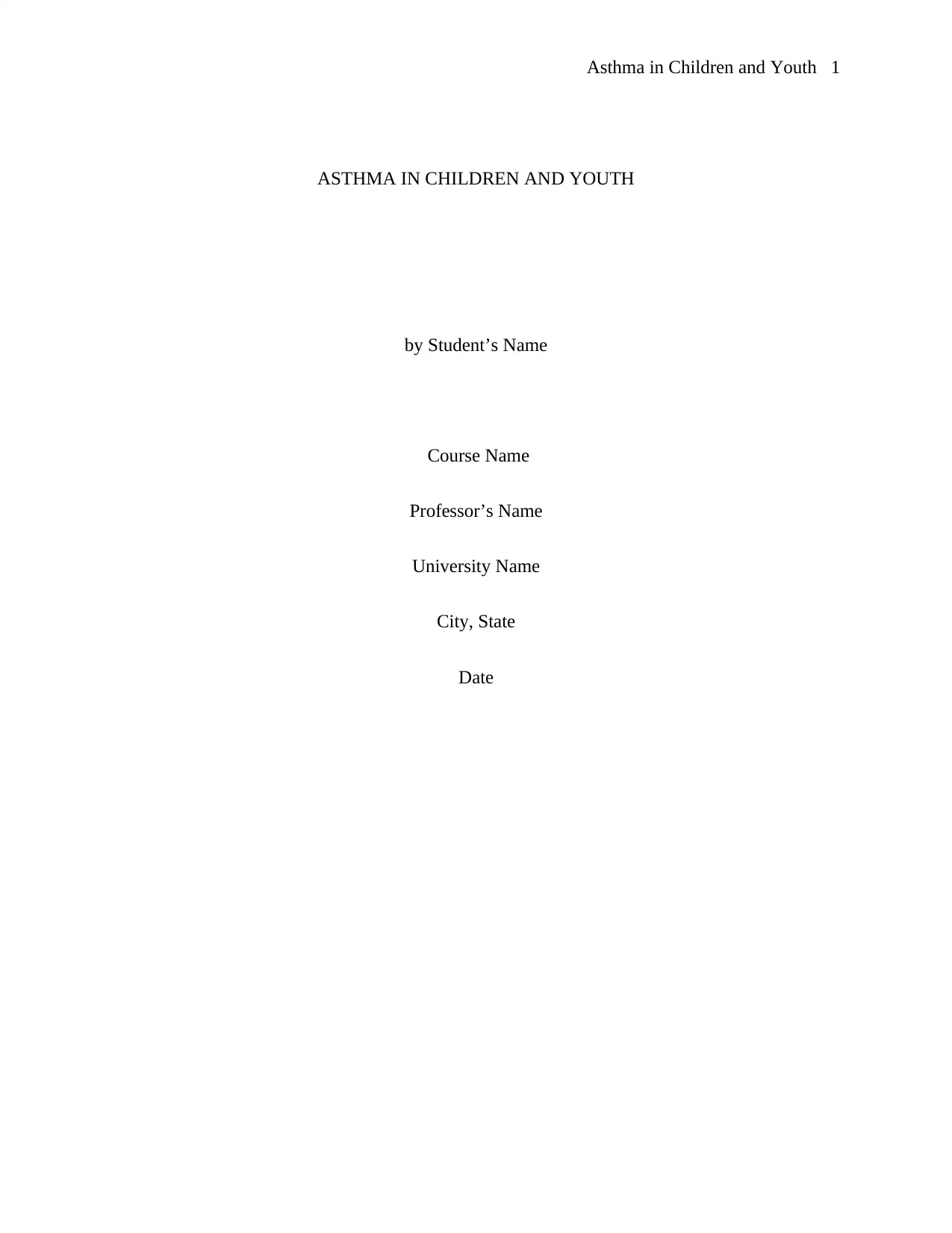
Asthma in Children and Youth 1
ASTHMA IN CHILDREN AND YOUTH
by Student’s Name
Course Name
Professor’s Name
University Name
City, State
Date
ASTHMA IN CHILDREN AND YOUTH
by Student’s Name
Course Name
Professor’s Name
University Name
City, State
Date
Paraphrase This Document
Need a fresh take? Get an instant paraphrase of this document with our AI Paraphraser
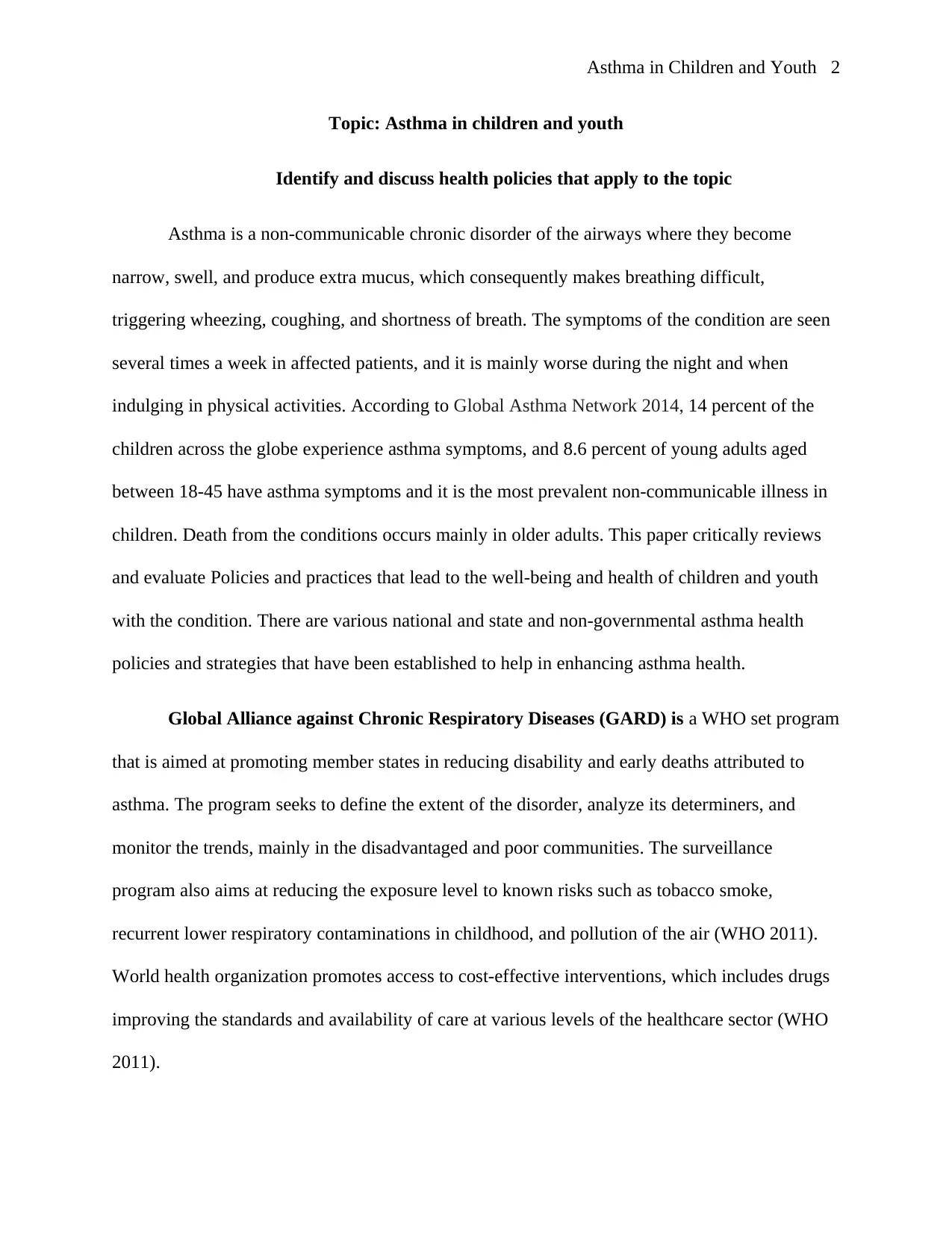
Asthma in Children and Youth 2
Topic: Asthma in children and youth
Identify and discuss health policies that apply to the topic
Asthma is a non-communicable chronic disorder of the airways where they become
narrow, swell, and produce extra mucus, which consequently makes breathing difficult,
triggering wheezing, coughing, and shortness of breath. The symptoms of the condition are seen
several times a week in affected patients, and it is mainly worse during the night and when
indulging in physical activities. According to Global Asthma Network 2014, 14 percent of the
children across the globe experience asthma symptoms, and 8.6 percent of young adults aged
between 18-45 have asthma symptoms and it is the most prevalent non-communicable illness in
children. Death from the conditions occurs mainly in older adults. This paper critically reviews
and evaluate Policies and practices that lead to the well-being and health of children and youth
with the condition. There are various national and state and non-governmental asthma health
policies and strategies that have been established to help in enhancing asthma health.
Global Alliance against Chronic Respiratory Diseases (GARD) is a WHO set program
that is aimed at promoting member states in reducing disability and early deaths attributed to
asthma. The program seeks to define the extent of the disorder, analyze its determiners, and
monitor the trends, mainly in the disadvantaged and poor communities. The surveillance
program also aims at reducing the exposure level to known risks such as tobacco smoke,
recurrent lower respiratory contaminations in childhood, and pollution of the air (WHO 2011).
World health organization promotes access to cost-effective interventions, which includes drugs
improving the standards and availability of care at various levels of the healthcare sector (WHO
2011).
Topic: Asthma in children and youth
Identify and discuss health policies that apply to the topic
Asthma is a non-communicable chronic disorder of the airways where they become
narrow, swell, and produce extra mucus, which consequently makes breathing difficult,
triggering wheezing, coughing, and shortness of breath. The symptoms of the condition are seen
several times a week in affected patients, and it is mainly worse during the night and when
indulging in physical activities. According to Global Asthma Network 2014, 14 percent of the
children across the globe experience asthma symptoms, and 8.6 percent of young adults aged
between 18-45 have asthma symptoms and it is the most prevalent non-communicable illness in
children. Death from the conditions occurs mainly in older adults. This paper critically reviews
and evaluate Policies and practices that lead to the well-being and health of children and youth
with the condition. There are various national and state and non-governmental asthma health
policies and strategies that have been established to help in enhancing asthma health.
Global Alliance against Chronic Respiratory Diseases (GARD) is a WHO set program
that is aimed at promoting member states in reducing disability and early deaths attributed to
asthma. The program seeks to define the extent of the disorder, analyze its determiners, and
monitor the trends, mainly in the disadvantaged and poor communities. The surveillance
program also aims at reducing the exposure level to known risks such as tobacco smoke,
recurrent lower respiratory contaminations in childhood, and pollution of the air (WHO 2011).
World health organization promotes access to cost-effective interventions, which includes drugs
improving the standards and availability of care at various levels of the healthcare sector (WHO
2011).
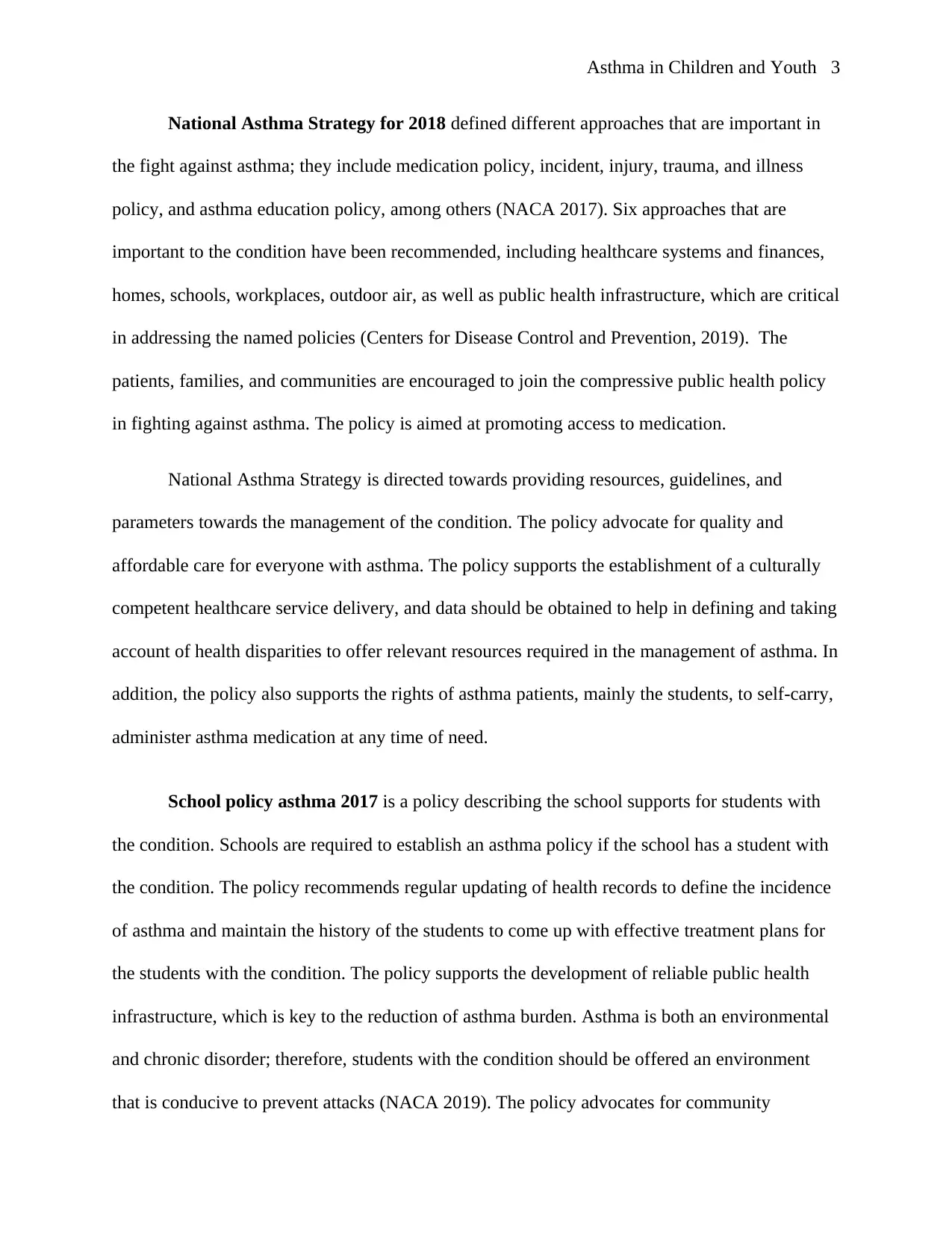
Asthma in Children and Youth 3
National Asthma Strategy for 2018 defined different approaches that are important in
the fight against asthma; they include medication policy, incident, injury, trauma, and illness
policy, and asthma education policy, among others (NACA 2017). Six approaches that are
important to the condition have been recommended, including healthcare systems and finances,
homes, schools, workplaces, outdoor air, as well as public health infrastructure, which are critical
in addressing the named policies (Centers for Disease Control and Prevention, 2019). The
patients, families, and communities are encouraged to join the compressive public health policy
in fighting against asthma. The policy is aimed at promoting access to medication.
National Asthma Strategy is directed towards providing resources, guidelines, and
parameters towards the management of the condition. The policy advocate for quality and
affordable care for everyone with asthma. The policy supports the establishment of a culturally
competent healthcare service delivery, and data should be obtained to help in defining and taking
account of health disparities to offer relevant resources required in the management of asthma. In
addition, the policy also supports the rights of asthma patients, mainly the students, to self-carry,
administer asthma medication at any time of need.
School policy asthma 2017 is a policy describing the school supports for students with
the condition. Schools are required to establish an asthma policy if the school has a student with
the condition. The policy recommends regular updating of health records to define the incidence
of asthma and maintain the history of the students to come up with effective treatment plans for
the students with the condition. The policy supports the development of reliable public health
infrastructure, which is key to the reduction of asthma burden. Asthma is both an environmental
and chronic disorder; therefore, students with the condition should be offered an environment
that is conducive to prevent attacks (NACA 2019). The policy advocates for community
National Asthma Strategy for 2018 defined different approaches that are important in
the fight against asthma; they include medication policy, incident, injury, trauma, and illness
policy, and asthma education policy, among others (NACA 2017). Six approaches that are
important to the condition have been recommended, including healthcare systems and finances,
homes, schools, workplaces, outdoor air, as well as public health infrastructure, which are critical
in addressing the named policies (Centers for Disease Control and Prevention, 2019). The
patients, families, and communities are encouraged to join the compressive public health policy
in fighting against asthma. The policy is aimed at promoting access to medication.
National Asthma Strategy is directed towards providing resources, guidelines, and
parameters towards the management of the condition. The policy advocate for quality and
affordable care for everyone with asthma. The policy supports the establishment of a culturally
competent healthcare service delivery, and data should be obtained to help in defining and taking
account of health disparities to offer relevant resources required in the management of asthma. In
addition, the policy also supports the rights of asthma patients, mainly the students, to self-carry,
administer asthma medication at any time of need.
School policy asthma 2017 is a policy describing the school supports for students with
the condition. Schools are required to establish an asthma policy if the school has a student with
the condition. The policy recommends regular updating of health records to define the incidence
of asthma and maintain the history of the students to come up with effective treatment plans for
the students with the condition. The policy supports the development of reliable public health
infrastructure, which is key to the reduction of asthma burden. Asthma is both an environmental
and chronic disorder; therefore, students with the condition should be offered an environment
that is conducive to prevent attacks (NACA 2019). The policy advocates for community
⊘ This is a preview!⊘
Do you want full access?
Subscribe today to unlock all pages.

Trusted by 1+ million students worldwide
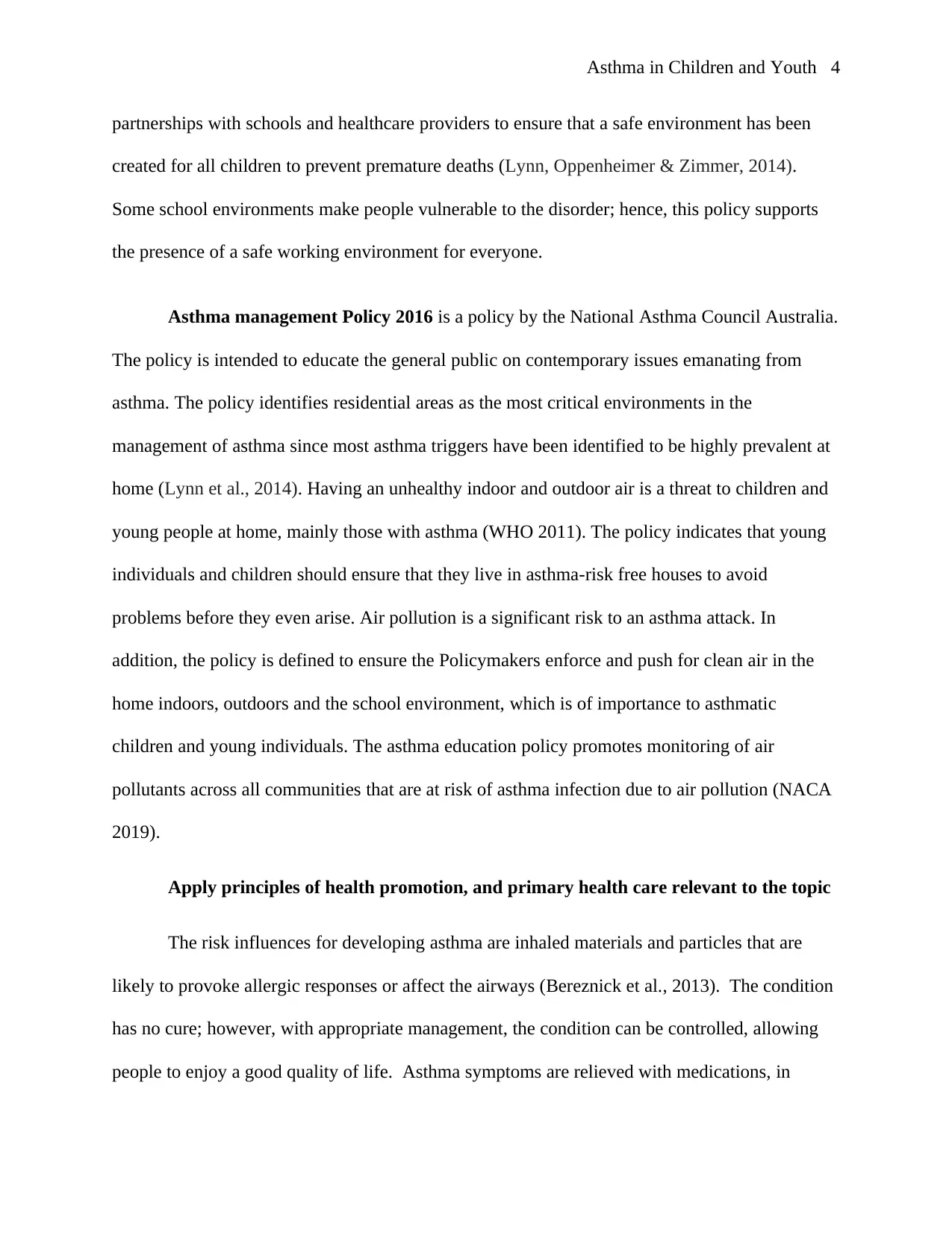
Asthma in Children and Youth 4
partnerships with schools and healthcare providers to ensure that a safe environment has been
created for all children to prevent premature deaths (Lynn, Oppenheimer & Zimmer, 2014).
Some school environments make people vulnerable to the disorder; hence, this policy supports
the presence of a safe working environment for everyone.
Asthma management Policy 2016 is a policy by the National Asthma Council Australia.
The policy is intended to educate the general public on contemporary issues emanating from
asthma. The policy identifies residential areas as the most critical environments in the
management of asthma since most asthma triggers have been identified to be highly prevalent at
home (Lynn et al., 2014). Having an unhealthy indoor and outdoor air is a threat to children and
young people at home, mainly those with asthma (WHO 2011). The policy indicates that young
individuals and children should ensure that they live in asthma-risk free houses to avoid
problems before they even arise. Air pollution is a significant risk to an asthma attack. In
addition, the policy is defined to ensure the Policymakers enforce and push for clean air in the
home indoors, outdoors and the school environment, which is of importance to asthmatic
children and young individuals. The asthma education policy promotes monitoring of air
pollutants across all communities that are at risk of asthma infection due to air pollution (NACA
2019).
Apply principles of health promotion, and primary health care relevant to the topic
The risk influences for developing asthma are inhaled materials and particles that are
likely to provoke allergic responses or affect the airways (Bereznick et al., 2013). The condition
has no cure; however, with appropriate management, the condition can be controlled, allowing
people to enjoy a good quality of life. Asthma symptoms are relieved with medications, in
partnerships with schools and healthcare providers to ensure that a safe environment has been
created for all children to prevent premature deaths (Lynn, Oppenheimer & Zimmer, 2014).
Some school environments make people vulnerable to the disorder; hence, this policy supports
the presence of a safe working environment for everyone.
Asthma management Policy 2016 is a policy by the National Asthma Council Australia.
The policy is intended to educate the general public on contemporary issues emanating from
asthma. The policy identifies residential areas as the most critical environments in the
management of asthma since most asthma triggers have been identified to be highly prevalent at
home (Lynn et al., 2014). Having an unhealthy indoor and outdoor air is a threat to children and
young people at home, mainly those with asthma (WHO 2011). The policy indicates that young
individuals and children should ensure that they live in asthma-risk free houses to avoid
problems before they even arise. Air pollution is a significant risk to an asthma attack. In
addition, the policy is defined to ensure the Policymakers enforce and push for clean air in the
home indoors, outdoors and the school environment, which is of importance to asthmatic
children and young individuals. The asthma education policy promotes monitoring of air
pollutants across all communities that are at risk of asthma infection due to air pollution (NACA
2019).
Apply principles of health promotion, and primary health care relevant to the topic
The risk influences for developing asthma are inhaled materials and particles that are
likely to provoke allergic responses or affect the airways (Bereznick et al., 2013). The condition
has no cure; however, with appropriate management, the condition can be controlled, allowing
people to enjoy a good quality of life. Asthma symptoms are relieved with medications, in
Paraphrase This Document
Need a fresh take? Get an instant paraphrase of this document with our AI Paraphraser
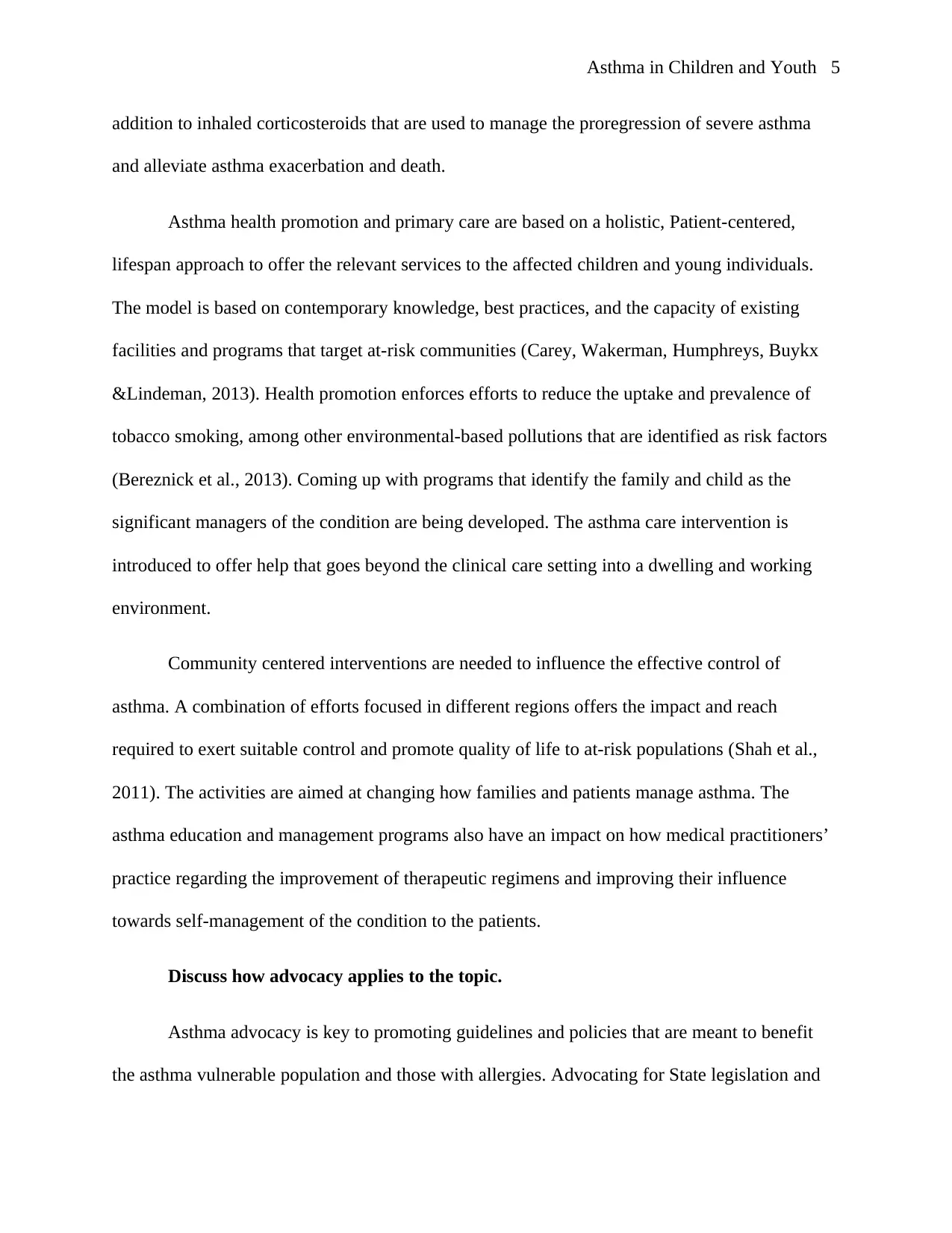
Asthma in Children and Youth 5
addition to inhaled corticosteroids that are used to manage the proregression of severe asthma
and alleviate asthma exacerbation and death.
Asthma health promotion and primary care are based on a holistic, Patient-centered,
lifespan approach to offer the relevant services to the affected children and young individuals.
The model is based on contemporary knowledge, best practices, and the capacity of existing
facilities and programs that target at-risk communities (Carey, Wakerman, Humphreys, Buykx
&Lindeman, 2013). Health promotion enforces efforts to reduce the uptake and prevalence of
tobacco smoking, among other environmental-based pollutions that are identified as risk factors
(Bereznick et al., 2013). Coming up with programs that identify the family and child as the
significant managers of the condition are being developed. The asthma care intervention is
introduced to offer help that goes beyond the clinical care setting into a dwelling and working
environment.
Community centered interventions are needed to influence the effective control of
asthma. A combination of efforts focused in different regions offers the impact and reach
required to exert suitable control and promote quality of life to at-risk populations (Shah et al.,
2011). The activities are aimed at changing how families and patients manage asthma. The
asthma education and management programs also have an impact on how medical practitioners’
practice regarding the improvement of therapeutic regimens and improving their influence
towards self-management of the condition to the patients.
Discuss how advocacy applies to the topic.
Asthma advocacy is key to promoting guidelines and policies that are meant to benefit
the asthma vulnerable population and those with allergies. Advocating for State legislation and
addition to inhaled corticosteroids that are used to manage the proregression of severe asthma
and alleviate asthma exacerbation and death.
Asthma health promotion and primary care are based on a holistic, Patient-centered,
lifespan approach to offer the relevant services to the affected children and young individuals.
The model is based on contemporary knowledge, best practices, and the capacity of existing
facilities and programs that target at-risk communities (Carey, Wakerman, Humphreys, Buykx
&Lindeman, 2013). Health promotion enforces efforts to reduce the uptake and prevalence of
tobacco smoking, among other environmental-based pollutions that are identified as risk factors
(Bereznick et al., 2013). Coming up with programs that identify the family and child as the
significant managers of the condition are being developed. The asthma care intervention is
introduced to offer help that goes beyond the clinical care setting into a dwelling and working
environment.
Community centered interventions are needed to influence the effective control of
asthma. A combination of efforts focused in different regions offers the impact and reach
required to exert suitable control and promote quality of life to at-risk populations (Shah et al.,
2011). The activities are aimed at changing how families and patients manage asthma. The
asthma education and management programs also have an impact on how medical practitioners’
practice regarding the improvement of therapeutic regimens and improving their influence
towards self-management of the condition to the patients.
Discuss how advocacy applies to the topic.
Asthma advocacy is key to promoting guidelines and policies that are meant to benefit
the asthma vulnerable population and those with allergies. Advocating for State legislation and
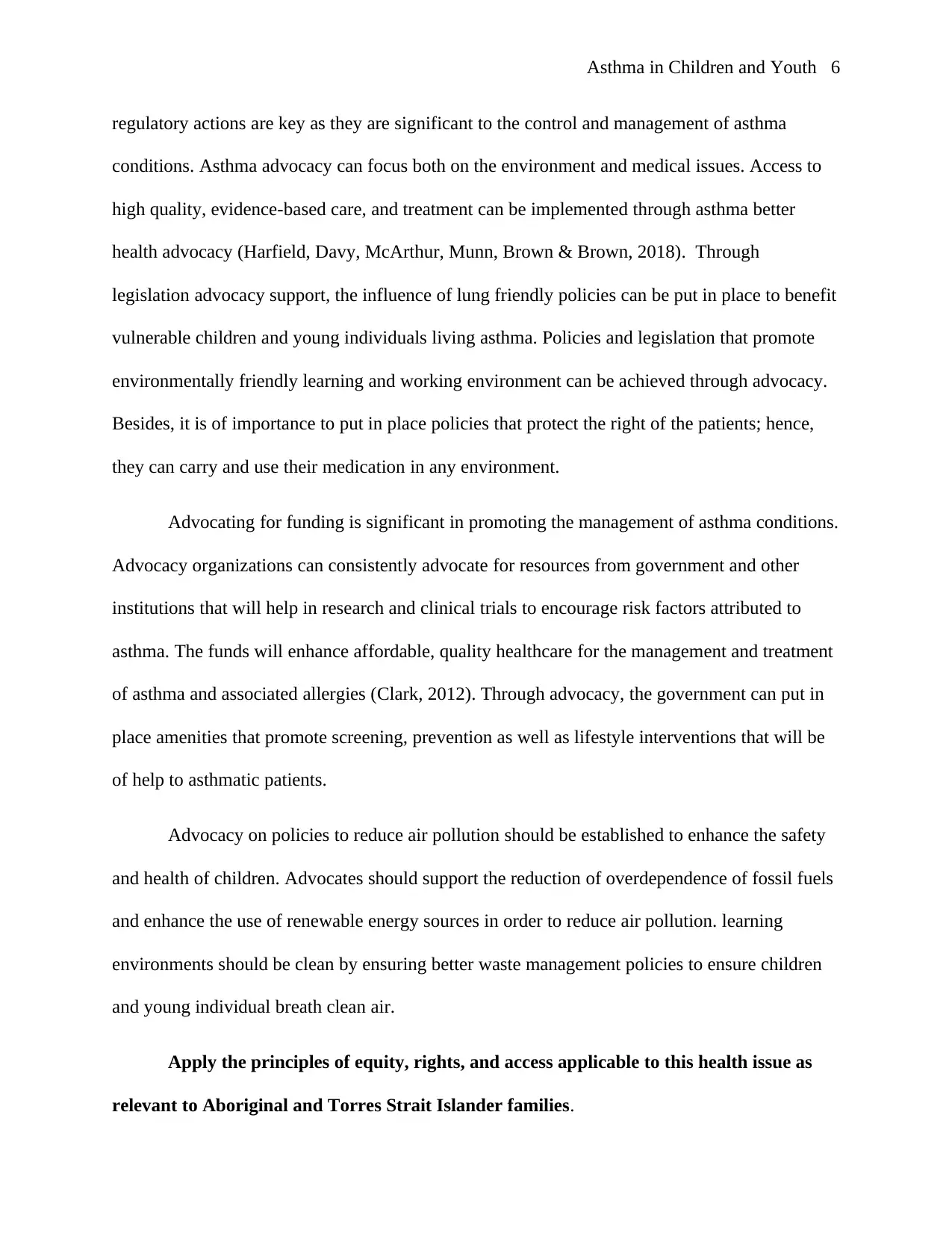
Asthma in Children and Youth 6
regulatory actions are key as they are significant to the control and management of asthma
conditions. Asthma advocacy can focus both on the environment and medical issues. Access to
high quality, evidence-based care, and treatment can be implemented through asthma better
health advocacy (Harfield, Davy, McArthur, Munn, Brown & Brown, 2018). Through
legislation advocacy support, the influence of lung friendly policies can be put in place to benefit
vulnerable children and young individuals living asthma. Policies and legislation that promote
environmentally friendly learning and working environment can be achieved through advocacy.
Besides, it is of importance to put in place policies that protect the right of the patients; hence,
they can carry and use their medication in any environment.
Advocating for funding is significant in promoting the management of asthma conditions.
Advocacy organizations can consistently advocate for resources from government and other
institutions that will help in research and clinical trials to encourage risk factors attributed to
asthma. The funds will enhance affordable, quality healthcare for the management and treatment
of asthma and associated allergies (Clark, 2012). Through advocacy, the government can put in
place amenities that promote screening, prevention as well as lifestyle interventions that will be
of help to asthmatic patients.
Advocacy on policies to reduce air pollution should be established to enhance the safety
and health of children. Advocates should support the reduction of overdependence of fossil fuels
and enhance the use of renewable energy sources in order to reduce air pollution. learning
environments should be clean by ensuring better waste management policies to ensure children
and young individual breath clean air.
Apply the principles of equity, rights, and access applicable to this health issue as
relevant to Aboriginal and Torres Strait Islander families.
regulatory actions are key as they are significant to the control and management of asthma
conditions. Asthma advocacy can focus both on the environment and medical issues. Access to
high quality, evidence-based care, and treatment can be implemented through asthma better
health advocacy (Harfield, Davy, McArthur, Munn, Brown & Brown, 2018). Through
legislation advocacy support, the influence of lung friendly policies can be put in place to benefit
vulnerable children and young individuals living asthma. Policies and legislation that promote
environmentally friendly learning and working environment can be achieved through advocacy.
Besides, it is of importance to put in place policies that protect the right of the patients; hence,
they can carry and use their medication in any environment.
Advocating for funding is significant in promoting the management of asthma conditions.
Advocacy organizations can consistently advocate for resources from government and other
institutions that will help in research and clinical trials to encourage risk factors attributed to
asthma. The funds will enhance affordable, quality healthcare for the management and treatment
of asthma and associated allergies (Clark, 2012). Through advocacy, the government can put in
place amenities that promote screening, prevention as well as lifestyle interventions that will be
of help to asthmatic patients.
Advocacy on policies to reduce air pollution should be established to enhance the safety
and health of children. Advocates should support the reduction of overdependence of fossil fuels
and enhance the use of renewable energy sources in order to reduce air pollution. learning
environments should be clean by ensuring better waste management policies to ensure children
and young individual breath clean air.
Apply the principles of equity, rights, and access applicable to this health issue as
relevant to Aboriginal and Torres Strait Islander families.
⊘ This is a preview!⊘
Do you want full access?
Subscribe today to unlock all pages.

Trusted by 1+ million students worldwide
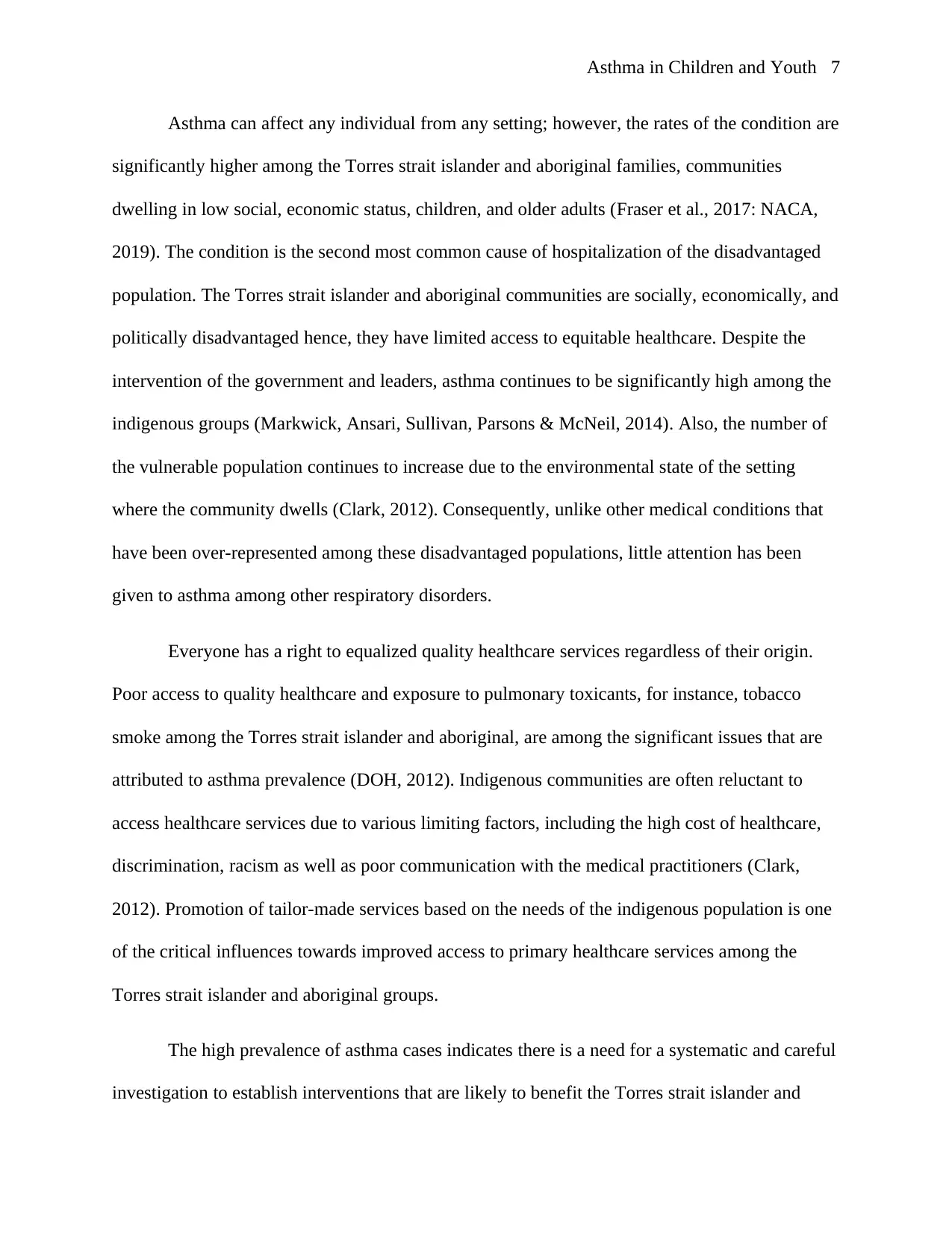
Asthma in Children and Youth 7
Asthma can affect any individual from any setting; however, the rates of the condition are
significantly higher among the Torres strait islander and aboriginal families, communities
dwelling in low social, economic status, children, and older adults (Fraser et al., 2017: NACA,
2019). The condition is the second most common cause of hospitalization of the disadvantaged
population. The Torres strait islander and aboriginal communities are socially, economically, and
politically disadvantaged hence, they have limited access to equitable healthcare. Despite the
intervention of the government and leaders, asthma continues to be significantly high among the
indigenous groups (Markwick, Ansari, Sullivan, Parsons & McNeil, 2014). Also, the number of
the vulnerable population continues to increase due to the environmental state of the setting
where the community dwells (Clark, 2012). Consequently, unlike other medical conditions that
have been over-represented among these disadvantaged populations, little attention has been
given to asthma among other respiratory disorders.
Everyone has a right to equalized quality healthcare services regardless of their origin.
Poor access to quality healthcare and exposure to pulmonary toxicants, for instance, tobacco
smoke among the Torres strait islander and aboriginal, are among the significant issues that are
attributed to asthma prevalence (DOH, 2012). Indigenous communities are often reluctant to
access healthcare services due to various limiting factors, including the high cost of healthcare,
discrimination, racism as well as poor communication with the medical practitioners (Clark,
2012). Promotion of tailor-made services based on the needs of the indigenous population is one
of the critical influences towards improved access to primary healthcare services among the
Torres strait islander and aboriginal groups.
The high prevalence of asthma cases indicates there is a need for a systematic and careful
investigation to establish interventions that are likely to benefit the Torres strait islander and
Asthma can affect any individual from any setting; however, the rates of the condition are
significantly higher among the Torres strait islander and aboriginal families, communities
dwelling in low social, economic status, children, and older adults (Fraser et al., 2017: NACA,
2019). The condition is the second most common cause of hospitalization of the disadvantaged
population. The Torres strait islander and aboriginal communities are socially, economically, and
politically disadvantaged hence, they have limited access to equitable healthcare. Despite the
intervention of the government and leaders, asthma continues to be significantly high among the
indigenous groups (Markwick, Ansari, Sullivan, Parsons & McNeil, 2014). Also, the number of
the vulnerable population continues to increase due to the environmental state of the setting
where the community dwells (Clark, 2012). Consequently, unlike other medical conditions that
have been over-represented among these disadvantaged populations, little attention has been
given to asthma among other respiratory disorders.
Everyone has a right to equalized quality healthcare services regardless of their origin.
Poor access to quality healthcare and exposure to pulmonary toxicants, for instance, tobacco
smoke among the Torres strait islander and aboriginal, are among the significant issues that are
attributed to asthma prevalence (DOH, 2012). Indigenous communities are often reluctant to
access healthcare services due to various limiting factors, including the high cost of healthcare,
discrimination, racism as well as poor communication with the medical practitioners (Clark,
2012). Promotion of tailor-made services based on the needs of the indigenous population is one
of the critical influences towards improved access to primary healthcare services among the
Torres strait islander and aboriginal groups.
The high prevalence of asthma cases indicates there is a need for a systematic and careful
investigation to establish interventions that are likely to benefit the Torres strait islander and
Paraphrase This Document
Need a fresh take? Get an instant paraphrase of this document with our AI Paraphraser
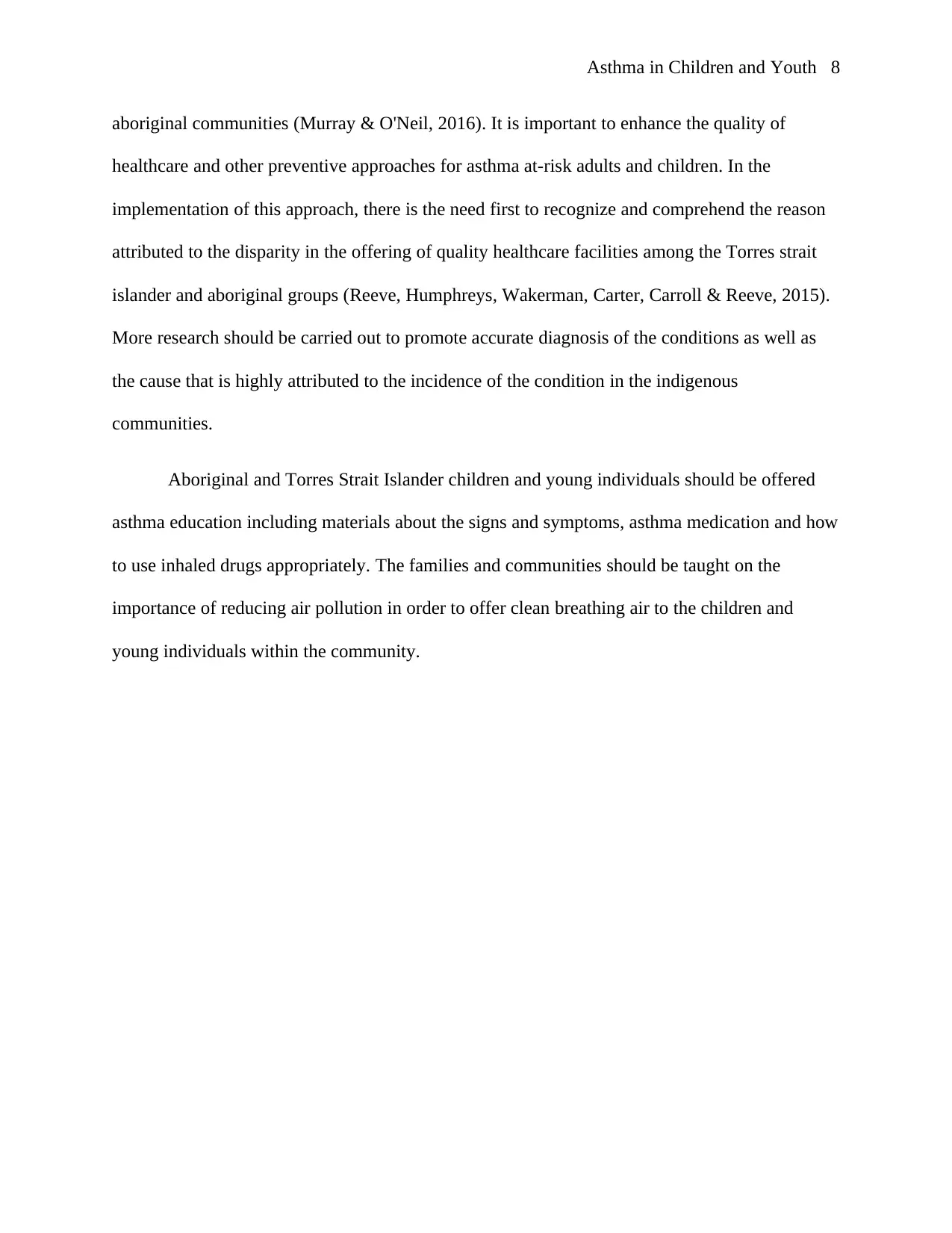
Asthma in Children and Youth 8
aboriginal communities (Murray & O'Neil, 2016). It is important to enhance the quality of
healthcare and other preventive approaches for asthma at-risk adults and children. In the
implementation of this approach, there is the need first to recognize and comprehend the reason
attributed to the disparity in the offering of quality healthcare facilities among the Torres strait
islander and aboriginal groups (Reeve, Humphreys, Wakerman, Carter, Carroll & Reeve, 2015).
More research should be carried out to promote accurate diagnosis of the conditions as well as
the cause that is highly attributed to the incidence of the condition in the indigenous
communities.
Aboriginal and Torres Strait Islander children and young individuals should be offered
asthma education including materials about the signs and symptoms, asthma medication and how
to use inhaled drugs appropriately. The families and communities should be taught on the
importance of reducing air pollution in order to offer clean breathing air to the children and
young individuals within the community.
aboriginal communities (Murray & O'Neil, 2016). It is important to enhance the quality of
healthcare and other preventive approaches for asthma at-risk adults and children. In the
implementation of this approach, there is the need first to recognize and comprehend the reason
attributed to the disparity in the offering of quality healthcare facilities among the Torres strait
islander and aboriginal groups (Reeve, Humphreys, Wakerman, Carter, Carroll & Reeve, 2015).
More research should be carried out to promote accurate diagnosis of the conditions as well as
the cause that is highly attributed to the incidence of the condition in the indigenous
communities.
Aboriginal and Torres Strait Islander children and young individuals should be offered
asthma education including materials about the signs and symptoms, asthma medication and how
to use inhaled drugs appropriately. The families and communities should be taught on the
importance of reducing air pollution in order to offer clean breathing air to the children and
young individuals within the community.
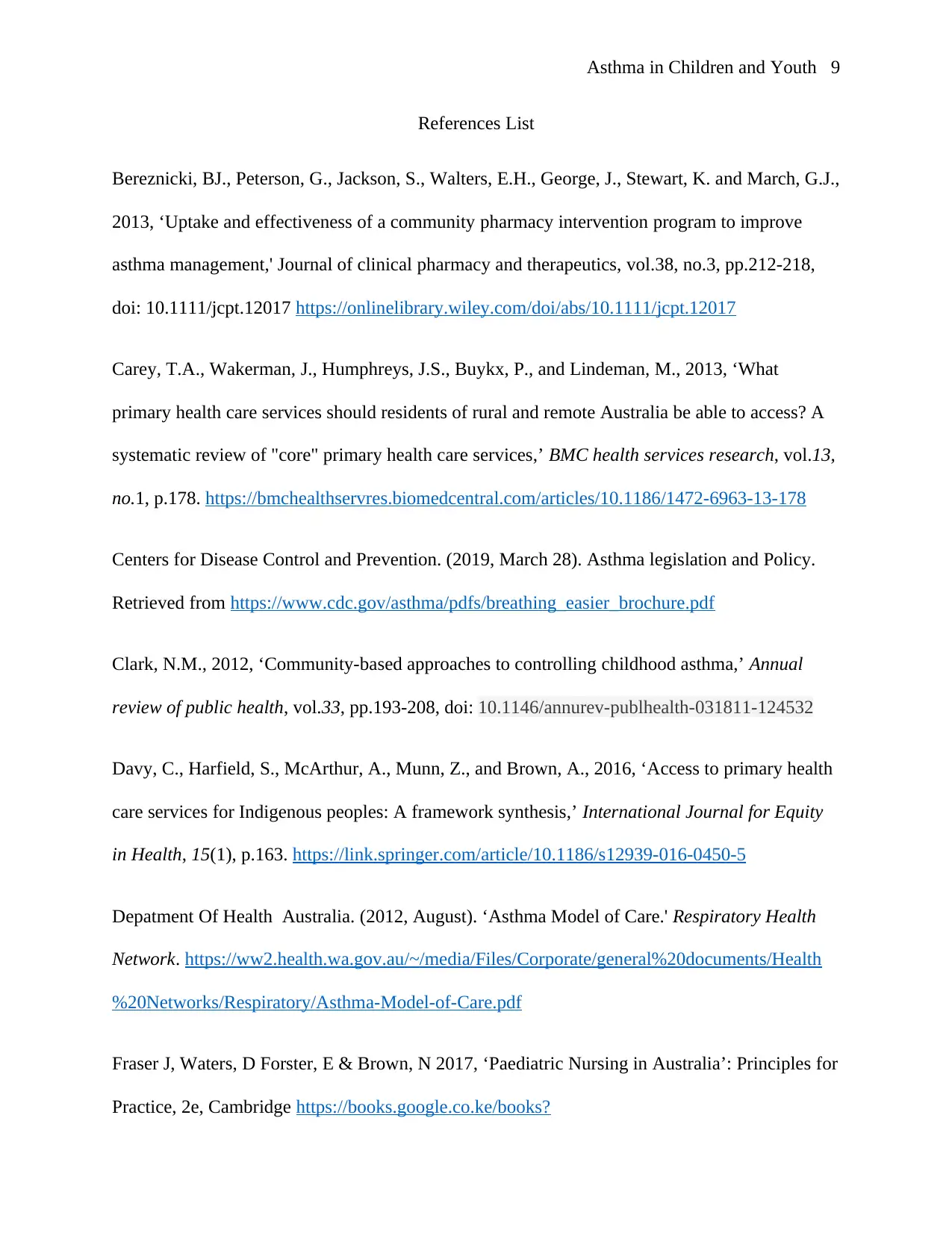
Asthma in Children and Youth 9
References List
Bereznicki, BJ., Peterson, G., Jackson, S., Walters, E.H., George, J., Stewart, K. and March, G.J.,
2013, ‘Uptake and effectiveness of a community pharmacy intervention program to improve
asthma management,' Journal of clinical pharmacy and therapeutics, vol.38, no.3, pp.212-218,
doi: 10.1111/jcpt.12017 https://onlinelibrary.wiley.com/doi/abs/10.1111/jcpt.12017
Carey, T.A., Wakerman, J., Humphreys, J.S., Buykx, P., and Lindeman, M., 2013, ‘What
primary health care services should residents of rural and remote Australia be able to access? A
systematic review of "core" primary health care services,’ BMC health services research, vol.13,
no.1, p.178. https://bmchealthservres.biomedcentral.com/articles/10.1186/1472-6963-13-178
Centers for Disease Control and Prevention. (2019, March 28). Asthma legislation and Policy.
Retrieved from https://www.cdc.gov/asthma/pdfs/breathing_easier_brochure.pdf
Clark, N.M., 2012, ‘Community-based approaches to controlling childhood asthma,’ Annual
review of public health, vol.33, pp.193-208, doi: 10.1146/annurev-publhealth-031811-124532
Davy, C., Harfield, S., McArthur, A., Munn, Z., and Brown, A., 2016, ‘Access to primary health
care services for Indigenous peoples: A framework synthesis,’ International Journal for Equity
in Health, 15(1), p.163. https://link.springer.com/article/10.1186/s12939-016-0450-5
Depatment Of Health Australia. (2012, August). ‘Asthma Model of Care.' Respiratory Health
Network. https://ww2.health.wa.gov.au/~/media/Files/Corporate/general%20documents/Health
%20Networks/Respiratory/Asthma-Model-of-Care.pdf
Fraser J, Waters, D Forster, E & Brown, N 2017, ‘Paediatric Nursing in Australia’: Principles for
Practice, 2e, Cambridge https://books.google.co.ke/books?
References List
Bereznicki, BJ., Peterson, G., Jackson, S., Walters, E.H., George, J., Stewart, K. and March, G.J.,
2013, ‘Uptake and effectiveness of a community pharmacy intervention program to improve
asthma management,' Journal of clinical pharmacy and therapeutics, vol.38, no.3, pp.212-218,
doi: 10.1111/jcpt.12017 https://onlinelibrary.wiley.com/doi/abs/10.1111/jcpt.12017
Carey, T.A., Wakerman, J., Humphreys, J.S., Buykx, P., and Lindeman, M., 2013, ‘What
primary health care services should residents of rural and remote Australia be able to access? A
systematic review of "core" primary health care services,’ BMC health services research, vol.13,
no.1, p.178. https://bmchealthservres.biomedcentral.com/articles/10.1186/1472-6963-13-178
Centers for Disease Control and Prevention. (2019, March 28). Asthma legislation and Policy.
Retrieved from https://www.cdc.gov/asthma/pdfs/breathing_easier_brochure.pdf
Clark, N.M., 2012, ‘Community-based approaches to controlling childhood asthma,’ Annual
review of public health, vol.33, pp.193-208, doi: 10.1146/annurev-publhealth-031811-124532
Davy, C., Harfield, S., McArthur, A., Munn, Z., and Brown, A., 2016, ‘Access to primary health
care services for Indigenous peoples: A framework synthesis,’ International Journal for Equity
in Health, 15(1), p.163. https://link.springer.com/article/10.1186/s12939-016-0450-5
Depatment Of Health Australia. (2012, August). ‘Asthma Model of Care.' Respiratory Health
Network. https://ww2.health.wa.gov.au/~/media/Files/Corporate/general%20documents/Health
%20Networks/Respiratory/Asthma-Model-of-Care.pdf
Fraser J, Waters, D Forster, E & Brown, N 2017, ‘Paediatric Nursing in Australia’: Principles for
Practice, 2e, Cambridge https://books.google.co.ke/books?
⊘ This is a preview!⊘
Do you want full access?
Subscribe today to unlock all pages.

Trusted by 1+ million students worldwide
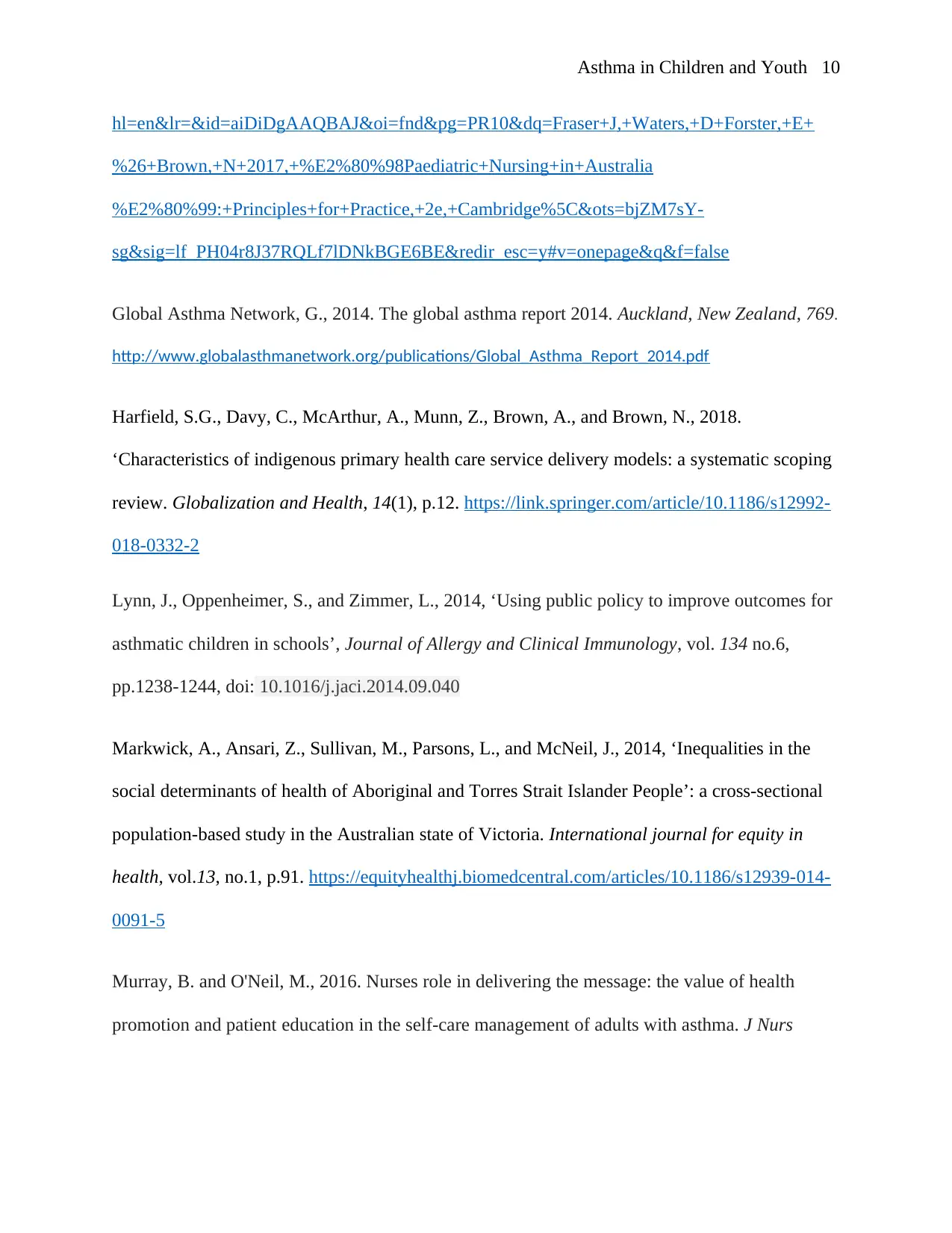
Asthma in Children and Youth 10
hl=en&lr=&id=aiDiDgAAQBAJ&oi=fnd&pg=PR10&dq=Fraser+J,+Waters,+D+Forster,+E+
%26+Brown,+N+2017,+%E2%80%98Paediatric+Nursing+in+Australia
%E2%80%99:+Principles+for+Practice,+2e,+Cambridge%5C&ots=bjZM7sY-
sg&sig=lf_PH04r8J37RQLf7lDNkBGE6BE&redir_esc=y#v=onepage&q&f=false
Global Asthma Network, G., 2014. The global asthma report 2014. Auckland, New Zealand, 769.
http://www.globalasthmanetwork.org/publications/Global_Asthma_Report_2014.pdf
Harfield, S.G., Davy, C., McArthur, A., Munn, Z., Brown, A., and Brown, N., 2018.
‘Characteristics of indigenous primary health care service delivery models: a systematic scoping
review. Globalization and Health, 14(1), p.12. https://link.springer.com/article/10.1186/s12992-
018-0332-2
Lynn, J., Oppenheimer, S., and Zimmer, L., 2014, ‘Using public policy to improve outcomes for
asthmatic children in schools’, Journal of Allergy and Clinical Immunology, vol. 134 no.6,
pp.1238-1244, doi: 10.1016/j.jaci.2014.09.040
Markwick, A., Ansari, Z., Sullivan, M., Parsons, L., and McNeil, J., 2014, ‘Inequalities in the
social determinants of health of Aboriginal and Torres Strait Islander People’: a cross-sectional
population-based study in the Australian state of Victoria. International journal for equity in
health, vol.13, no.1, p.91. https://equityhealthj.biomedcentral.com/articles/10.1186/s12939-014-
0091-5
Murray, B. and O'Neil, M., 2016. Nurses role in delivering the message: the value of health
promotion and patient education in the self-care management of adults with asthma. J Nurs
hl=en&lr=&id=aiDiDgAAQBAJ&oi=fnd&pg=PR10&dq=Fraser+J,+Waters,+D+Forster,+E+
%26+Brown,+N+2017,+%E2%80%98Paediatric+Nursing+in+Australia
%E2%80%99:+Principles+for+Practice,+2e,+Cambridge%5C&ots=bjZM7sY-
sg&sig=lf_PH04r8J37RQLf7lDNkBGE6BE&redir_esc=y#v=onepage&q&f=false
Global Asthma Network, G., 2014. The global asthma report 2014. Auckland, New Zealand, 769.
http://www.globalasthmanetwork.org/publications/Global_Asthma_Report_2014.pdf
Harfield, S.G., Davy, C., McArthur, A., Munn, Z., Brown, A., and Brown, N., 2018.
‘Characteristics of indigenous primary health care service delivery models: a systematic scoping
review. Globalization and Health, 14(1), p.12. https://link.springer.com/article/10.1186/s12992-
018-0332-2
Lynn, J., Oppenheimer, S., and Zimmer, L., 2014, ‘Using public policy to improve outcomes for
asthmatic children in schools’, Journal of Allergy and Clinical Immunology, vol. 134 no.6,
pp.1238-1244, doi: 10.1016/j.jaci.2014.09.040
Markwick, A., Ansari, Z., Sullivan, M., Parsons, L., and McNeil, J., 2014, ‘Inequalities in the
social determinants of health of Aboriginal and Torres Strait Islander People’: a cross-sectional
population-based study in the Australian state of Victoria. International journal for equity in
health, vol.13, no.1, p.91. https://equityhealthj.biomedcentral.com/articles/10.1186/s12939-014-
0091-5
Murray, B. and O'Neil, M., 2016. Nurses role in delivering the message: the value of health
promotion and patient education in the self-care management of adults with asthma. J Nurs
Paraphrase This Document
Need a fresh take? Get an instant paraphrase of this document with our AI Paraphraser
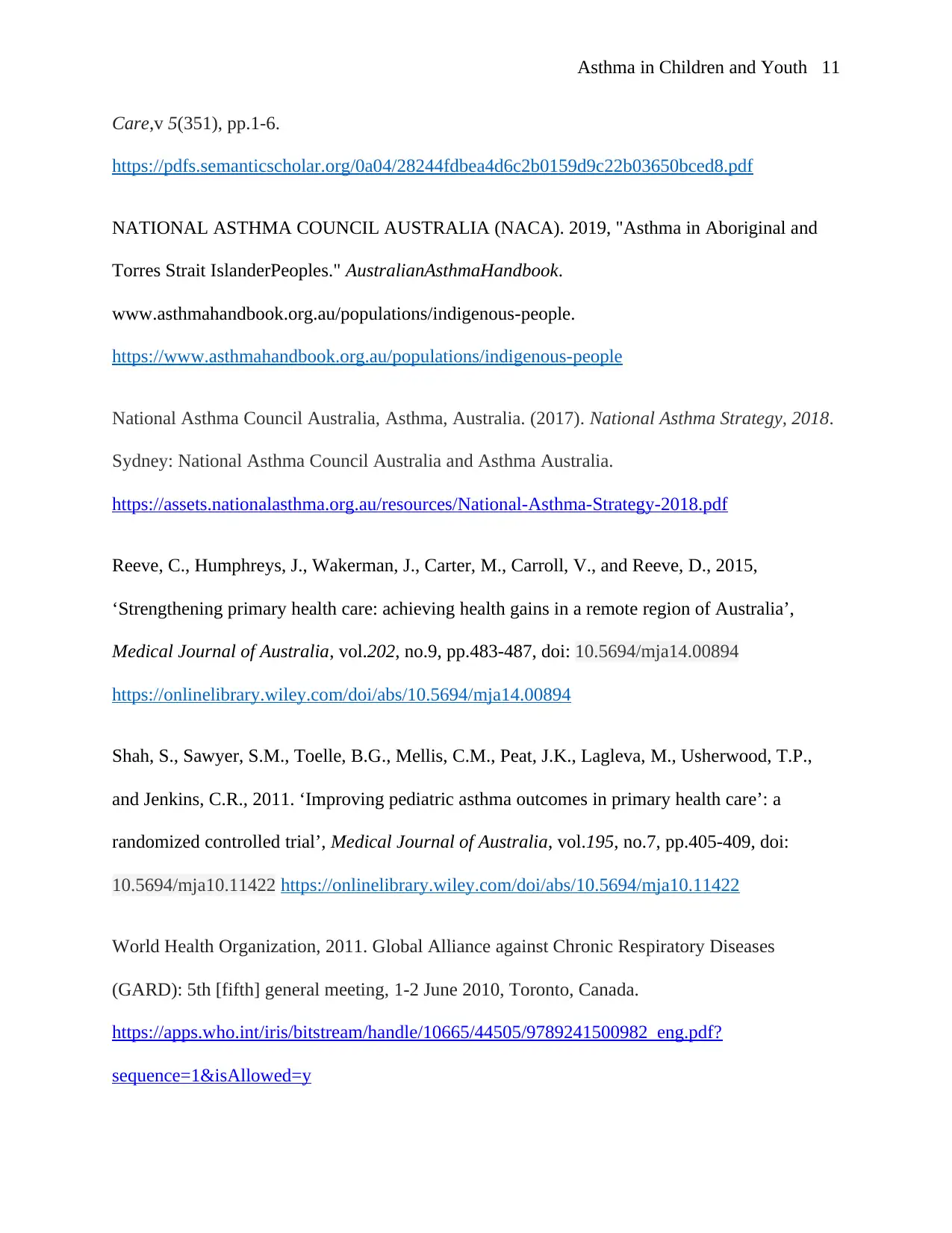
Asthma in Children and Youth 11
Care,v 5(351), pp.1-6.
https://pdfs.semanticscholar.org/0a04/28244fdbea4d6c2b0159d9c22b03650bced8.pdf
NATIONAL ASTHMA COUNCIL AUSTRALIA (NACA). 2019, "Asthma in Aboriginal and
Torres Strait IslanderPeoples." AustralianAsthmaHandbook.
www.asthmahandbook.org.au/populations/indigenous-people.
https://www.asthmahandbook.org.au/populations/indigenous-people
National Asthma Council Australia, Asthma, Australia. (2017). National Asthma Strategy, 2018.
Sydney: National Asthma Council Australia and Asthma Australia.
https://assets.nationalasthma.org.au/resources/National-Asthma-Strategy-2018.pdf
Reeve, C., Humphreys, J., Wakerman, J., Carter, M., Carroll, V., and Reeve, D., 2015,
‘Strengthening primary health care: achieving health gains in a remote region of Australia’,
Medical Journal of Australia, vol.202, no.9, pp.483-487, doi: 10.5694/mja14.00894
https://onlinelibrary.wiley.com/doi/abs/10.5694/mja14.00894
Shah, S., Sawyer, S.M., Toelle, B.G., Mellis, C.M., Peat, J.K., Lagleva, M., Usherwood, T.P.,
and Jenkins, C.R., 2011. ‘Improving pediatric asthma outcomes in primary health care’: a
randomized controlled trial’, Medical Journal of Australia, vol.195, no.7, pp.405-409, doi:
10.5694/mja10.11422 https://onlinelibrary.wiley.com/doi/abs/10.5694/mja10.11422
World Health Organization, 2011. Global Alliance against Chronic Respiratory Diseases
(GARD): 5th [fifth] general meeting, 1-2 June 2010, Toronto, Canada.
https://apps.who.int/iris/bitstream/handle/10665/44505/9789241500982_eng.pdf?
sequence=1&isAllowed=y
Care,v 5(351), pp.1-6.
https://pdfs.semanticscholar.org/0a04/28244fdbea4d6c2b0159d9c22b03650bced8.pdf
NATIONAL ASTHMA COUNCIL AUSTRALIA (NACA). 2019, "Asthma in Aboriginal and
Torres Strait IslanderPeoples." AustralianAsthmaHandbook.
www.asthmahandbook.org.au/populations/indigenous-people.
https://www.asthmahandbook.org.au/populations/indigenous-people
National Asthma Council Australia, Asthma, Australia. (2017). National Asthma Strategy, 2018.
Sydney: National Asthma Council Australia and Asthma Australia.
https://assets.nationalasthma.org.au/resources/National-Asthma-Strategy-2018.pdf
Reeve, C., Humphreys, J., Wakerman, J., Carter, M., Carroll, V., and Reeve, D., 2015,
‘Strengthening primary health care: achieving health gains in a remote region of Australia’,
Medical Journal of Australia, vol.202, no.9, pp.483-487, doi: 10.5694/mja14.00894
https://onlinelibrary.wiley.com/doi/abs/10.5694/mja14.00894
Shah, S., Sawyer, S.M., Toelle, B.G., Mellis, C.M., Peat, J.K., Lagleva, M., Usherwood, T.P.,
and Jenkins, C.R., 2011. ‘Improving pediatric asthma outcomes in primary health care’: a
randomized controlled trial’, Medical Journal of Australia, vol.195, no.7, pp.405-409, doi:
10.5694/mja10.11422 https://onlinelibrary.wiley.com/doi/abs/10.5694/mja10.11422
World Health Organization, 2011. Global Alliance against Chronic Respiratory Diseases
(GARD): 5th [fifth] general meeting, 1-2 June 2010, Toronto, Canada.
https://apps.who.int/iris/bitstream/handle/10665/44505/9789241500982_eng.pdf?
sequence=1&isAllowed=y
1 out of 11
Related Documents
Your All-in-One AI-Powered Toolkit for Academic Success.
+13062052269
info@desklib.com
Available 24*7 on WhatsApp / Email
![[object Object]](/_next/static/media/star-bottom.7253800d.svg)
Unlock your academic potential
Copyright © 2020–2025 A2Z Services. All Rights Reserved. Developed and managed by ZUCOL.





